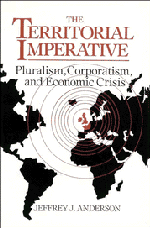Book contents
- Frontmatter
- Contents
- List of figures
- List of tables
- Preface
- 1 Introduction
- 2 Power-dependence and regional economic crisis
- 3 Central governments and regional policy
- 4 The British regions
- 5 The German Länder
- 6 The territorial imperative: Political logic interprets problem logic
- List of abbreviations
- Bibliography
- Index
3 - Central governments and regional policy
Published online by Cambridge University Press: 26 March 2010
- Frontmatter
- Contents
- List of figures
- List of tables
- Preface
- 1 Introduction
- 2 Power-dependence and regional economic crisis
- 3 Central governments and regional policy
- 4 The British regions
- 5 The German Länder
- 6 The territorial imperative: Political logic interprets problem logic
- List of abbreviations
- Bibliography
- Index
Summary
Although regional disparities in growth and employment are a universal feature of industrial economies, there is no generally accepted theory of regional economic development, only a collection of partial and often contradictory ideas. Traditional location factors, like the presence or absence of adequate infrastructure, skilled labor reserves, and markets, can determine whether firms decide to set up shop or to continue doing business in certain regions. To the extent that location factors are cumulatively negative or positive within a geographical area, regional stagnation or growth can result. The role of inherited industrial structure is also given considerable play. Through multiplier effects, a preponderance of fast-growing (declining) sectors can propel (restrain) the regional economy's overall growth rate. Other factors of importance include the overall performance of the macroeconomy, the role of urban markets, and the effects of governmental taxation and spending programs. Empirical research has established that few of these factors are completely irrelevant. As such, they suggest an imprecise set of prescriptions for national policymakers and regional interests. Like a collection of old folk remedies, they occasionally produce results, and therefore are difficult to dismiss out of hand.
Regional economic policy is the most transparent manner by which benefits are allocated to problem regions. The traditional rationale for a nationally administered regional economic policy is to promote interregional equity by inducing capital and labor to locate in areas which would not necessarily be chosen by investment decision makers. Such programs seek to alleviate regional disparities in unemployment, to prevent the breakdown of communities caused by the outmigration of the indigenous population, and to ensure relatively equal life chances across the national territory.
- Type
- Chapter
- Information
- The Territorial ImperativePluralism, Corporatism and Economic Crisis, pp. 57 - 100Publisher: Cambridge University PressPrint publication year: 1992



